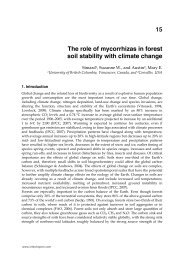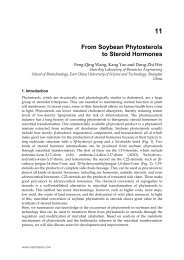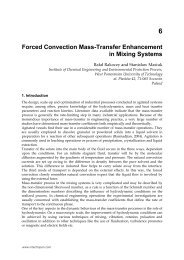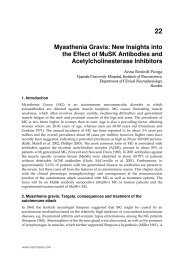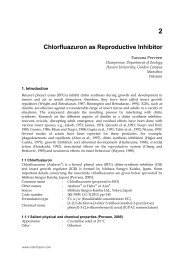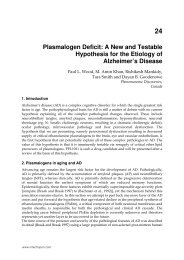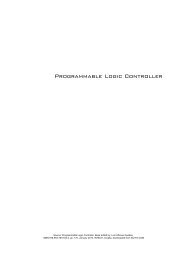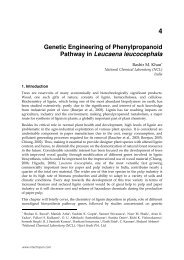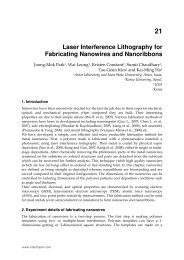Hemodialysis Vascular Access Dysfunction - InTech
Hemodialysis Vascular Access Dysfunction - InTech
Hemodialysis Vascular Access Dysfunction - InTech
You also want an ePaper? Increase the reach of your titles
YUMPU automatically turns print PDFs into web optimized ePapers that Google loves.
<strong>Hemodialysis</strong> <strong>Vascular</strong> <strong>Access</strong> <strong>Dysfunction</strong><br />
The current standard of care to prevent catheter thrombosis is installation of an<br />
anticoagulant in both dialysis ports at the completion of each dialysis session. In the United<br />
States, heparin is most commonly used, while in Europe citrate is the more common<br />
anticoagulant 6. The studies to-date have shown similar efficacy when comparing citrate to<br />
heparin for prophylaxis of catheter thrombosis, but with fewer complications of systemic<br />
bleeding with citrate 129-132. A recent multicenter, randomized-controlled trial has reported<br />
that use of a thrombolytic, tissue plasminogen activator as a locking solution compared to<br />
heparin had reduced incidence of catheter dysfunction 34.<br />
4.2 Catheter-related bacteremia<br />
Currently, a precise definition for diagnosis catheter-related bacteremia is lacking. More<br />
rigorous definitions require a positive blood culture obtained from the catheter and a<br />
peripheral vein with the quantitative colony count being at minimum four-fold higher from<br />
the catheter sample 133. However, recently, the Infectious Disease Society of America has<br />
recognized the challenges in obtaining peripheral blood cultures from hemodialysis patients<br />
(e.g. priority for preserving veins and difficult cannulations) and has considered a definition<br />
of “possible” catheter-related bacteremia as positive blood culture obtained from the<br />
catheter in a symptomatic patient 134.<br />
The two main pathways where organisms can gain entry into the blood stream to initiate<br />
catheter-related bacteremia are intraluminal and extraluminal 135. Organisms gain entrance<br />
through the bloodstream extraluminally through contact between the skin surface<br />
organisms and the external surface of the catheter at the time of catheter placement or<br />
following catheter placement before healing of the exit site or endothelialization of the<br />
subcutaneous tunnel 7. Subsequently, the organisms colonize or migrate through the<br />
intracutaneous exterior tract of the catheter to the tip, allowing for hematagenous dispersion<br />
of the organisms and leading to catheter-related bacteremia 7. Intraluminal-derived<br />
infections results from the transfer of organisms from hand contact with the catheter,<br />
leading to contamination of the internal catheter surfaces 7. Infection from the extraluminal<br />
pathway most commonly occurs immediately after catheter insertion, while infections from<br />
the intraluminal pathway occurs throughout the life of the catheter 7. Irrespective of the<br />
route of bacterial entry, the bacteria will either adhere to the CVC or become incorporated<br />
into a fibrin sheath. Adherence of the bacterial organisms to the CVC initiates a common<br />
pathway of biofilm production. A mature biofilm is a self-sustaining colony of<br />
microorganism, guarded by an exopolysaccharide matrix, that is stimulated and secreted by<br />
the organism and very difficult to eradicate 7,136-140.<br />
Catheter-related bacteremia can result in devastating complications such as endocarditis,<br />
osteomyelitis, thrombophlebitis, septic arthritis, spinal epidural abscess, and large atrial<br />
thrombi 30,31,141-149. The majority of isolated organisms from catheter-related bacteremia are<br />
gram-positive organisms (52-84%) with Staph Aureus responsible for the majority of these<br />
organisms 7,30,31,143,150,151. Gram-negative are isolated in 27-36% of episodes and fungal<br />
isolated are relatively uncommon (




